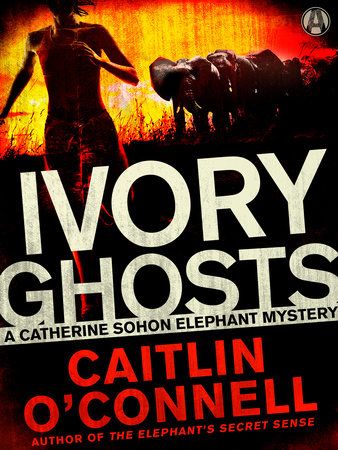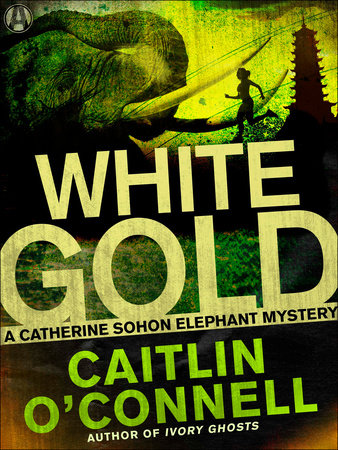Excerpt
Ivory Ghosts
Chapter 1
White dust settled like a fresh layer of snow on the gray bushes lining an infinite stretch of unpaved road. The place would have looked every bit like Yellowstone in winter, had it not been ninety-five degrees.
The base of my spine ached from a long day of driving, and I was desperate to get out and stretch my legs. Hypnotized by the monotony of the scenery, I’d missed the turnoff and circled back. Coming from the opposite direction, I found a hand-drawn sign demarking Susuwe Ranger Station in a break in the vegetation and turned left.
In the distance, the land dropped away as far as the eye could see. Golden-tufted reeds lined the tannin-colored Kwando River etched within an expansive floodplain below. Rust-colored grass rolled out to the horizon as the river snaked south on its way to Botswana to feed the great Okavango, the largest inland delta in the world.
The road got steeper and steeper as I descended the rise, making the potholes harder to navigate. Each bump challenged the poor welding job I’d done on the roof rack—the metal gas can, spare tire, and solar panel creaking in their brackets as the back tires hit the bottom of the potholes.
I couldn’t swerve quickly enough to avoid a small piece of sharp metal in the road. Suddenly, the car pulled right. “Damn it!” I was prepared for two flats—accumulated along the road through the Chobe—but not three.
I got out and looked at the tire. It was shredded beyond repair. “Shit!”
Driving my ’74 VW Bug all the way up to the northeast corner of Namibia from South Africa was probably a bad idea. But I had an emotional attachment to it, and I couldn’t afford a four-wheel drive on a month contract funded in Namibian dollars.
I fell against the passenger door and took a breath. Cicadas shook their insistent maracas from patches of dense bush. A massive baobab tree looked as if a giant rodent had gnawed through the middle, leaving a stump like an apple core. From the look of the overly pruned vegetation, it was clear I was back in elephant country—a welcome change after traveling the long dusty gap between the Chobe and the Kwando rivers with many villages and not much wildlife—but not so welcome on foot at this time of day. Elephant country meant wild country—where I was part of the food chain.
My hands started shaking; I hadn’t eaten since the crackers I’d had for breakfast before leaving Victoria Falls in the early morning. I hadn’t wanted to stop driving since. I took a warm swig from my water bottle, poured some onto my bandana, and wiped my face, taking a moment to enjoy the sensation before digging around the backseat for the crackers and peanut butter.
Eating on a rock next to the car, I struggled to keep the cloud of accumulating sweat bees out of my mouth and eyes. I pulled out my map and drew a line from the main road up to the border of Angola, seven miles north. The road wound through a canopy of gnarled acacia trees that formed a seam with the floodplain and then carried on straight north following the river. The ranger station was supposed to be somewhere along that seam, probably about an hour’s walk away.
Judging from the height of the sun, I had just about an hour of daylight left. I had to choose between walking to the station or staying with the car and hoping for a lift. Since there hadn’t been a single car on the road in several hours, it seemed like a better idea to walk. Having already spent a night in the backseat of the Beetle, I preferred not to repeat it.
Feeling stronger with some food in my stomach, I grabbed my water, my useless cellphone—out of range for the past two hours—the map, a headlamp, more crackers, and a light sweater and stuffed them into my backpack. I reached into the glove compartment for my holster and strapped my .45 around my waist. I grabbed six rounds of ammunition from the box, opened the cylinder, and loaded the revolver. If I ended up surrounded by elephants after dark with no trees to climb, I could at least make a noise.
I put my pack on and headed for the ranger’s station. The road became sandy and flattened out for a while. I passed the tracks of a large herd of buffalo crossing the road, heading toward the river. Clusters of yellow butterflies fluttered above damp urine patches here and there. A baby tortoise swam through the deeper sand along the shoulder. Despite the lack of traffic, I followed my instinct to pick it up and move it out of the road.
The terrain got steeper, the road turning sharply left and then changed in consistency to hard-pack clay again. Cicadas were back at it with their brash rhythmic calls. Termite mounds rose up amid the mopane trees with enormous white mushrooms sprouting out of the bases.
The ruts got deeper as I made my awkward descent down another steep hill. Metal debris was strewn about on the road along with a piece of rubber—maybe from a bumper. As the road bent around again, I saw an old Mercedes sedan pulled off at an angle. Through the back window, I could see that the front windshield had been shattered. It wasn’t clear whether there was anyone still in the car.
There was a dark swath leading off into the bush, like an animal may have been hit and wounded—the only explanation for the impact on the front and side of the car, other than a collision with another vehicle. If an animal had hauled itself off the road, it was very large, and perhaps still alive. I reached into my holster and pulled out my gun. The last thing I needed was to be confronted by a wounded buffalo.
As I got closer, what had looked like a branch was a motionless arm hanging out the window. I moved slower.
“Hello?”
The air was dead still but for the buzzing of flies, the first responders to an accident in Africa. The thick, iron-sweet scent of nearly fresh blood assaulted me. But there was something extra, something I was familiar with in the wildlife business. The aroma of a fresh kill was a cocktail of blood mixed with rumen and a hint of anal scent gland.
I looked down to see the tracks of another vehicle, probably a 4x4 pickup truck. There were boot prints of at least three people, and a scuffle of tracks around the trunk. The plates of the car were from Zimbabwe.
There was no sign of life in the car. My throat tightened as I approached the driver’s side. I had seen a lot of dead animals in my days as a ranger, but I wasn’t accustomed to seeing dead people. The driver, a woman, was slumped over the steering wheel. She’d been shot in the head, and the wounds on her back indicated that she was shot in either the chest or back, I couldn’t tell. Part of the passenger’s head had been shot completely off. The man in the back was facedown, with a blood-soaked head and back: two men and a woman.
I took quick breaths, fighting the reflex to vomit as I reached into my pack for my cellphone and dialed Craig’s number, but was greeted by the dreaded bleep, bleep, bleep of no reception. I threw the phone on the ground a little too hard and it bounced, smashing on a rock.
“Shit! Shit! Shit!” I put the now-broken phone into my pocket and swallowed hard. Craig would have to wait for an update. Not that I thought my boss could rescue me from my current predicament, but I was hoping to hear a voice—to be connected to another warm body—and not be alone among the dead.
I walked to the slightly opened trunk of the car and cracked it open farther with the barrel of my gun. The smell of putrefaction bludgeoned my senses. In the corner, the carcass of a scaly anteater lay in a soupy mess, its scales falling off rotting skin. From the scrape marks and dirt in the center of the trunk, it looked as if something very heavy had been removed.
I rifled through the dirt with the edge of the barrel of my gun. There were some small white jagged pieces of what looked like slivers of tusk. I looked closely at the dried smears of blood and mud covering the thin broken ridges of elephant incisors that had been pulled out at the base. There must have been a good amount of ivory here.
I picked up a chip and as I inspected it, I heard a slight movement in the bush and took a quick step back. I put the piece of ivory in my pocket and held my revolver tightly in both hands. Trying to avoid thorns, I walked slowly into the bushes. A guttural noise stopped me in my tracks.
I stood on my toes to peer above the bush. Not ten steps away, a lioness crouched behind a body, her golden eyes locked onto me, looking ready to pounce. Walking backward, I shifted my gaze from her eyes to the man slumped in a pool of fly-covered sticky blood. The skin had been removed from his face, and his skull was sliced off three-quarters up like a soft-boiled egg. Inside, it was empty. The brain had been removed.





